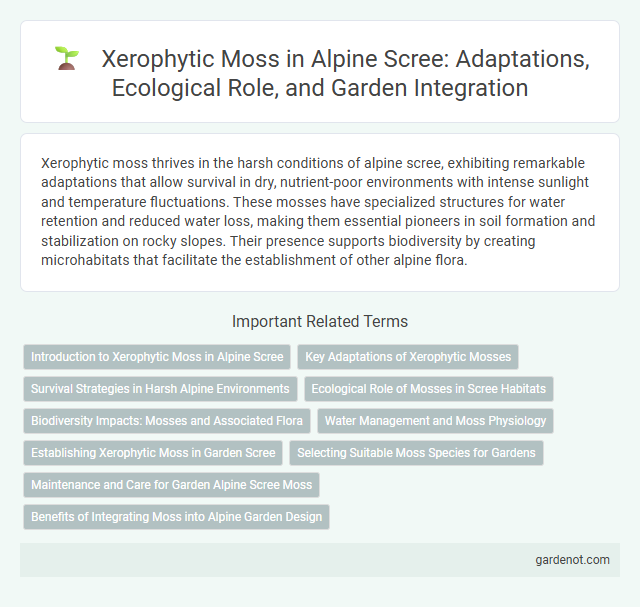Xerophytic moss thrives in the harsh conditions of alpine scree, exhibiting remarkable adaptations that allow survival in dry, nutrient-poor environments with intense sunlight and temperature fluctuations. These mosses have specialized structures for water retention and reduced water loss, making them essential pioneers in soil formation and stabilization on rocky slopes. Their presence supports biodiversity by creating microhabitats that facilitate the establishment of other alpine flora.
Introduction to Xerophytic Moss in Alpine Scree
Xerophytic mosses in alpine scree are specially adapted to survive in extreme conditions characterized by low moisture, high solar radiation, and unstable rocky substrates. These mosses exhibit structural adaptations such as dense cushions and reduced leaf surface area, which minimize water loss and protect against desiccation. Their presence stabilizes scree slopes, promotes soil formation, and supports microhabitats crucial for alpine biodiversity.
Key Adaptations of Xerophytic Mosses
Xerophytic mosses in alpine scree exhibit specialized adaptations such as efficient water retention mechanisms including thickened cell walls and a dense cuticle to minimize desiccation. Their ability to enter a dormant state during extreme drought enables survival in harsh, nutrient-poor conditions typical of alpine environments. These mosses also possess a high tolerance for temperature fluctuations and UV radiation, critical for thriving amidst the exposed, rocky slopes of scree habitats.
Survival Strategies in Harsh Alpine Environments
Xerophytic mosses in alpine scree exhibit remarkable adaptations such as desiccation tolerance, enabling them to survive prolonged drought by entering a dormant state and rapidly rehydrating when moisture returns. Their ability to photosynthesize at low temperatures and minimize water loss through specialized cell structures supports persistence in nutrient-poor, freeze-thaw environments. These survival strategies allow xerophytic mosses to colonize and stabilize unstable scree slopes, contributing to early soil formation in harsh alpine ecosystems.
Ecological Role of Mosses in Scree Habitats
Xerophytic mosses play a crucial ecological role in alpine scree habitats by stabilizing loose rock fragments and reducing soil erosion, thus facilitating succession in these harsh environments. Their ability to retain moisture and create microhabitats supports invertebrate communities and promotes nutrient cycling within nutrient-poor substrates. These mosses enhance biodiversity by providing a foundation for vascular plant colonization and improving overall ecosystem resilience under extreme temperature and moisture fluctuations.
Biodiversity Impacts: Mosses and Associated Flora
Xerophytic mosses in alpine scree environments create microhabitats that support diverse biological communities by retaining moisture and stabilizing soil. These mosses facilitate the growth of specialized vascular plants and fungi, enhancing overall biodiversity in otherwise harsh and nutrient-poor conditions. Their presence contributes to ecological resilience by promoting species richness and maintaining ecosystem functions in alpine scree landscapes.
Water Management and Moss Physiology
Xerophytic moss in alpine scree exhibits specialized water management strategies, including the ability to retain moisture through dense cell walls and a thick cuticle that reduces water loss in harsh, arid conditions. Its physiology is adapted to withstand desiccation by entering a dormant state, allowing metabolic functions to resume rapidly upon rehydration. These adaptations enable the moss to survive and maintain hydration balance despite the extreme fluctuations in water availability characteristic of alpine scree environments.
Establishing Xerophytic Moss in Garden Scree
Establishing xerophytic moss in garden scree requires selecting species such as Syntrichia ruralis and Grimmia pulvinata, which thrive in well-drained, nutrient-poor substrates typical of alpine scree environments. Proper site preparation includes ensuring coarse, gritty soil with excellent drainage and minimal organic matter to mimic natural scree conditions and promote moss adhesion. Regular monitoring of moisture levels during establishment, combined with indirect sunlight exposure, helps xerophytic moss adapt, enhancing erosion control and aesthetic value in alpine garden landscapes.
Selecting Suitable Moss Species for Gardens
Xerophytic moss species such as Syntrichia ruralis and Tortula ruralis are ideal for alpine scree garden settings due to their exceptional drought tolerance and ability to thrive in well-drained, rocky substrates. These mosses require minimal water and can withstand temperature fluctuations common in alpine environments, making them suitable for low-maintenance green spaces. Selecting native or well-adapted xerophytic mosses enhances ecological resilience and aesthetic appeal in harsh garden conditions.
Maintenance and Care for Garden Alpine Scree Moss
Xerophytic moss in alpine scree gardens requires minimal watering due to its drought-resistant nature, thriving in well-drained, nutrient-poor soils with ample sunlight. Regularly remove debris and avoid heavy foot traffic to maintain its delicate structure and prevent damage. Seasonal pruning encourages healthy growth while preventing moss overgrowth, ensuring a sustainable and vibrant scree garden environment.
Benefits of Integrating Moss into Alpine Garden Design
Xerophytic moss enhances alpine garden design by improving soil stability and reducing erosion on steep, rocky screes. Its ability to retain moisture supports drought-resistant plant communities, creating a more resilient ecosystem. Integrating this moss also promotes biodiversity by providing microhabitats for small invertebrates and beneficial microorganisms.
Xerophytic moss Infographic

 gardenot.com
gardenot.com